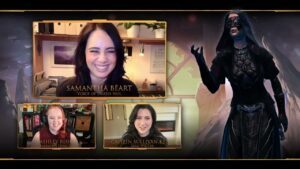In March, Capcom will release Dragon’s Dogma 2, the long-awaited sequel to its inventive 2012 action RPG. It’ll be the first mainline release in the open-world fantasy series in 12 years, and fans are eager to see what Capcom will bring to the table after a decade-plus of advancement in technical innovation and open-world game design.
With its release just a couple of months away and a trove of new details revealed as part of January’s IGN First coverage, we’ve put together this breakdown of everything you need to know about Dragon’s Dogma 2.
Jump to:
Dragon’s Dogma 2 Release Date
Barring a delay, Dragon’s Dogma 2 will be released on March 22, 2024.
Dragon’s Dogma 2 Platforms and Price
Dragon’s Dogma 2 is coming to PS5, Xbox Series X|S, and PC (via Steam). It is the first Capcom game to cost $70 USD.
Dragon’s Dogma 2 Special Editions, Pre-Order Bonuses
In addition to the standard edition, Capcom is offering a Deluxe Edition of Dragon’s Dogma 2 for $80. It includes the following:
- Dragon’s Dogma 2 base game
- Explorer’s Camping Kit
- 1,500 rift crystals (used to hire pawns or purchase special items)
- Dragon’s Dogma Music & Sound Collection (option to “change some in-game music and sound effects to those of the original Dragon’s Dogma”)
- Six in-game items: Wakestone, Art of Metamorphosis, Harpysnare Smoke Beacons, Ambivalent Rift Incense, Heartfelt Pendant, and Makeshift Gaol Key
Pre-ordering the standard edition of Dragon’s Dogma 2 will net you the Superior Weapons quartet: a sword, daggers, staff, and bow.
Preordering the Deluxe Edition will net you the Superior Weapons Quartet and the Ring of Assurance.
Dragon’s Dogma 2 Story
The story begins in an underground gaol where the Dragon’s voice echoes in the fog of lost memories.
Ascend, Arisen, and best me, in accordance with the dogma of this world.
Betwixt the domains of human and beastren, A hero must fulfill their forgotten destiny.
What dogma does your heart see through your eyes?
‘Tis a tale of one who shall slay the Dragon and claim the throne.
Thus reads the story synopsis for Dragon’s Dogma 2, a sequel set in a parallel world that “mirrors the world setting of the original game.” Like the first game, the sequel’s story revolves around the Arisen, who embarks on a perilous journey to reclaim their stolen heart from the Dragon.
“That’s why the story of constant rebirth that’s focused around dragons,” game director Hideaki Itsuno told IGN,” as well as the various elements of the world shown in the previous game have all carried over to this one as well. That said, it does take place in a different parallel world, which is why I think there will be parts that are similar yet different.”
The world consists of two prosperous nations: Vermund, the human kingdom, where the player becomes entangled in a power struggle for the throne; and Battahl, a “rugged canyon nation” that’s home to the beastren (humanoid cats, à la The Elder Scrolls’ Khajiit) led by the preistess Nadinia. The player finds themselves caught between these two nations and their differing cultures and philosophies.
Character Creation and NPCs
In Dragon’s Dogma 2, you play as a fully customizable Arisen. Players can choose to create a human, elf, or beastren — each of which has two body types, nine base bodies per type, and countless heads on which facial features can be tweaked.
“The first idea we had was to scan nearly a hundred human faces,” said Itsuno, “then use those as a base for creating characters. This real-life data acting as our base meant that it would be easy to create realistic faces so long as you don’t apply absolutely ridiculous values to them.”
Players will encounter “a ridiculous number” of NPCs, who can give sidequests to and build relationships with your Arisen. Itsuno told IGN he wanted to create “properly details NPCs” who move throughout the world and their lives irrespective of what the player is doing.
As in the original game, NPCs in Dragon’s Dogma 2 can grow to like or dislike your playable character depending on your actions. What’s new, however, is the added layer of NPCs liking or disliking you based on your behavior toward other NPCs in their orbit. Itsuno provided the following example: “If you find a pair of friends, hitting one will cause the other to get mad at you too. Or if you do something nice for a child, the parent might thank you and like you more as well. That’s what I mean by relationships between NPCs.”
Itsuno added NPCs may also get into fights with each other if another NPCs relationship with the player threatens theirs. He noted this feature is still being finalize. If added to the final game, it may work something like this: “A character who grows close to you might come over to your house to play,” said Itsuno, “but if they meet another character there who’s done the same thing, a fight might break out. Personally, we just made the system because we wanted to be able to say, ‘Stop, don’t fight over me!’ It might be best if your readers play through the game while trying to avoid that kind of outcome.”
Dragon’s Dogma 2 Gameplay
Vocations and Combat
Dragon’s Dogma 2 is an action-heavy RPG built around player choice and third-person combat. Combat in Dragon’s Dogma 2 is dependent on the player character’s vocation (the game’s term for what are generally known as classes). Players will start by choosing from four vocations:
- Thief: Equipped with daggers, Thiefs are agile fighters who thrive at close range.
- Mage: A ranged specialist, Mages can cast attack, healing, and support spells.
- Fighter: True to its name, a Fighter is a melee specialist, equipped with a one-handed sword and shield.
- Archer: Effective at long range, Archers are equipped with a bow and arrows with varying effects.
Should you grow wary of your vocation, or should you encounter a boss fight that requires a specific approach, you can change it throughout the game at Vocation Guilds.
As the story progresses, players will unlock Advanced Vocations:
- Mystic Spearhead: A vocation that blends short-ranged weaponry and long-ranged magic.
- Magick Archer: An archer equipped with magic arrows and healer/support abilities.
- Warrior: A melee specialist that can wield powerful, two-handed weapons.
- Sorcerer: A magic user that casts more powerful spells with their two-handed staff.
- Trickster: A one-of-a-kind vocation, Tricksters are equipped with a ceremonial Censer and specialize in illusion-based methods of distraction.
Pawns
Returning from the original game is Dragon’s Dogma’s pawn system. Pawns are AI-controlled companions designed to make the single-player adventure feel shared. You’ll be able to travel with one player-created pawn and up to two others created by others. These downloaded pawns will come with all of their experiences from the other player’s adventure, meaning they may come equipped with gear you’ve yet to find or provide useful information about quests they’ve been through that you’ve yet to complete.
During our hands-on time with Dragon’s Dogma 2, we noted pawns (and NPCs in general) “are much better this time around at guiding the player to a quest, or pointing out areas of interest, basically themselves acting as replacements for UI elements like markers or arrows.”
A new twist on pawns in the sequel is specializations, or special abilities. For example, a pawn may have the Woodland Wordsmith specialization if their Arisen possesses that ability, allowing them, and therefore you, to translate Elvish speech or text. (The Elvish spoken/written in Dragon’s Dogma 2 is an orignal language created by the game’s story writer.)
Itsuno noted the negative feedback from the first game around pawns repeating dialogue. “We’ve done whatever we can to keep pawns from repeating the same lines multiple times,” he said.
Map Size
Dragon’s Dogma 2 is set in a high-fantasy world inspired by classical paintings and medieval art. Players will explore a map roughly four times larger than the original. Despite the massive size of the map, Itsuno claims there isn’t much wasted space:
“I don’t want to go too far and make people think I’m exaggerating, but we’ve placed items on the map and figured out ways to guide the player’s eye so that there aren’t any moments when they feel bored,” he said. “This is something that other action games often do as well, and one of the basic elements in such games is the ability to see your destination while being unsure of how to get there, moving from scene to scene.”
The game director likens the exploration to climbing a mountain, which he and his team did in preparation for making Dragon’s Dogma 2:
“When we climbed mountains, there were times when the closest way to the summit was a straight line there, but nobody takes those routes,” he said. “Everyone takes paths that circle around the mountain, so we’d talk about why they did that instead of using some other route, and the answer is that it looks so tough. It’s not that you want to go but can’t, it’s that you don’t even consider taking that route to begin with. That’s why there’s a number of different paths to the top, and we all take different routes to the summit.
“Nobody thinks of that as a lack of choice, right? That’s the kind of thing we talked about, saying that instead of creating a map that lets you go anywhere you want, placing areas that players won’t want to visit on it will let us decide where we want to focus on while not making the map feel any less free because users will avoid those other places, just like the mountain we were climbing.”
As far as traversing the map, players won’t be able to rely on unrestricted fast travel in Dragon’s Dogma 2. While the addition of Oxcarts, which enable travel along specific paths, adds a new wrinkle to traversal, the game is designed to be explored on foot.
“Just give it a try,” said Itsuno. “Travel is boring? That’s not true. It’s only an issue because your game is boring. All you have to do is make travel fun. That’s why you place things in the right location for players to discover, or come up with enemy appearance methods that create different experiences each time, or force players into blind situations where they don’t know whether it’s safe or not ten meters in front of them.”
In our hands-on preview of Dragon’s Dogma 2, IGN’s Mitchell Saltzman said Capcom has successfully doubled down on what made the original action RPG so unique, improving combat, exploration, and the functon of pawns. However, he noted, “After an hour of killing the usual Dragon’s Dogma rogue’s gallery of goblins, cyclops, saurians, harpies, bandits, and attempting occasional Griffin, I couldn’t help but wish that I experienced something that truly felt new in this sequel.”
That being said, our hands-on time was limited to one hour, so stay tuned for IGN’s final review to see how these pros and cons play out in the context of the full game.
Dragon’s Dogma 2 Development
Dragon’s Dogma 2 is developed and published by Capcom. It’s again directed by Hideaki Itsuno, who directed the original game back in 2012. He most recently directed Devil May Cry 5 for Capcom.
The sequel was created in RE Engine “to provide an all-too-real world of fantasy, intricately crafted with gorgeous visuals,” according to Capcom. The engine has been used to develop most of Capcom’s major titles since Resident Evil 7 in 2017.
Dragon’s Dogma 2 was officially announced in 2022, though it was first spotted in a massive data breach at Capcom back in 2020.
How to Play Dragon’s Dogma 1
Let’s answer the big question up front: No, you do not have to play Dragon’s Dogma to understand or enjoy the sequel. However, Itsuno says playing the first game will help with a player’s understanding of the world and how to effectively utilize the pawn system.
The first game was initially released on PS3 and Xbox 360. However, you won’t need to dust off your old hardware to play it. An expanded version of the original, titled Dragon’s Dogma: Dark Arisen, is available on those original consoles as well as Nintendo Switch, PS4, Xbox One, and PC. This expanded edition adds 10-15 hours of content, according to our Dark Arisen review, making it the recommended way to play through the original.
Dedicated fans may also remember the Japan-exclusive MMO, Dragon’s Dogma Online, though those servers were shut down in 2019.
Those interested in more from the franchise ahead of the sequel can check out the Dragon’s Dogma anime adaptation on Netflix. IGN’s review of Netflix’s Dragon’s Dogma praised its action and visuals while knocking its “meandering plot.”
Jordan covers games, shows, and movies as a freelance writer for IGN.























